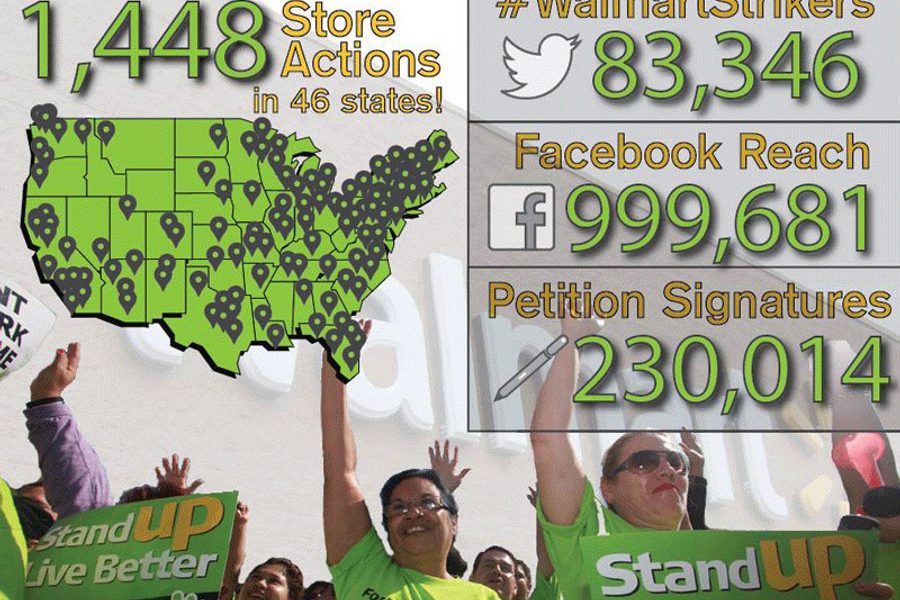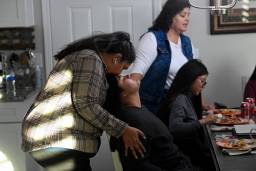How Walmart Organizers Turned the Internet Into a Shop Floor
Walmart workers and organizers prove ‘clicktivism’ can evolve into offline activism.
Sarah Jaffe

The basic tools of labor organizing haven’t changed in hundreds of years. There’s no substitute for face-to-face conversations about working conditions and what can be done to change them. Organizers still make home visits, and workers still talk to one another in the break room or the parking lot.
But in the new wave of low-wage worker organizing that has swept the country in the past two years, some labor groups have begun to use the Internet to facilitate the kinds of personal conversations that lead to workplace action. As unions, community organizations, workers centers and even “netroots” groups like MoveOn.org pour resources into organizing a massive, diffuse fast-food and retail workforce that had often been written off as unorganizable, the web has provided a cheap, effective tool to reach low-wage workers in ways that are both personal and lasting. In particular, the United Food and Commercial Workers-backed groups OUR Walmart and Making Change at Walmart have enthusiastically experimented with web tools in their recent efforts to make a difference at the nation’s biggest retailer.
As Jamie Way, an online organizer with Making Change at Walmart, puts it, “We’re never going to match [Walmart] in terms of resources, we’re never going to have an organizer or a community supporter on the ground in every one of their [more than] 4,000 Walmarts.” To combat this, the campaign has created online spaces for organizers to reach workers and for communities to support local efforts. And those online connections can, in turn, drive offline actions.
Of the estimated 1,500 Walmart protests that occurred across the country on Black Friday last year, many were planned online, organized either directly by OUR Walmart or using its templates and tools. Much of that turnout came from the kind of efforts that have become commonplace in recent years — creating Facebook event pages, for example, or posting links to event websites on Twitter.
But some of the campaign’s efforts are decidedly more innovative.
During the lead-up to this past year’s Black Friday actions, OUR Walmart unveiled AssociateVoices, a website where Walmart workers could post their stories about their experiences on the job and request a protest at their particular store, even if they themselves were not ready to go on strike. “The idea was to illustrate this silent majority that exists at these stores,” Way says.
“Walmart’s constant refrain has been that it’s a very small number of disgruntled associates and community- and labor-backed groups that are [speaking out]. AssociateVoices was intentionally designed to show that these complaints are not just made up, these are very real things that happen at Walmart,” says Raymond Suelzer, the web developer for Making Change at Walmart and the architect of AssociateVoices.
“For those of us who last worked retail 20-plus years ago (or more — or never!), reading the discussion boards is an eye-opener,” writes Kati Sipp, a longtime union organizer and creator of the future-of-labor blog HackTheUnion.org, in an email to In These Times.
Worker complaints on AssociateVoices do often get very specific. One worker in Billings, Montana suggested that management should “Quit listening to a computer to tell you how to run a store,” and “Fix the razor sharp door handles around the store”; in Virginia, a worker identifying herself as Tori writes that when she was pregnant, her manager refused to grant schedule changes that would allow her to care for her children. But there are also common threads that run throughout — the standard refrains of not enough hours and insufficient pay, and everywhere calls for respect.
AssociateVoices is just OUR Walmart’s latest effort to connect Walmart workers with each other online, however. According to Suelzer, the group has been using social media to that end for the last three years or so. Facebook’s targeted advertising allows OUR Walmart to run ads directed at the thousands of users who list Walmart as their employer. Those ads send workers to OUR Walmart’s page, where they are then able to connect with other Walmart associates. And then, Suelzer says, these conversations around workplace issues go offline.
“We’ve seen that when workers talk to one another it doesn’t just stay on the Facebook page,” Suelzer says. “Those relationships become real, in that they’re talking offsite. Most of our online work is worker-to-worker. We have a couple of organizers who oversee and provide feedback to workers, but so much of it really is a substantial number of online leaders who are really taking initiative and reaching out to other workers.”
That’s exactly how Lucas Handy discovered OUR Walmart. An overnight customer service manager at the Walmart in Fort Dodge, Iowa, he was complaining about his job on Facebook when he saw an ad for the organization pop up on his sidebar. Intrigued, he clicked and found himself talking with Angela Wilson, an organizer from Florida, who invited him to an OUR Walmart summit for workers in her state. Walmart had warned the workers to avoid OUR Walmart — that they’d risk being fired if they got involved with the organization — but Handy took the risk and went to the meeting.
When he returned, he remained a silent member, participating online but not taking action in his store, for a while, until another manager’s homophobic slur became the last straw. “That was the icing on the cake, that made me step up and speak out,” he says. He went through the steps that his store had laid out to report the abusive behavior, but instead of that manager facing consequences, he says, Handy himself was demoted to a position as a pharmacy technician. “I lost my pay, I lost hours, I lost healthcare, I lost everything,” he says. “The day I was supposed to start [at the] pharmacy was the day I went on strike, on a two-week strike.”.
Shortly after he went on strike and then took a trip to Netroots Nation to speak about his part in the Walmart campaign, Handy was fired — the reason Walmart gave, he says, was that he’d misled management about the time he took off to attend the conference. But he still volunteers as the LGBT liaison for OUR Walmart, maintaining a closed Facebook group for LGBT Walmart workers to discuss their issues in a safe space and reaching out to other Walmart workers in other Facebook groups to which he belongs. “People are more comfortable online than they are person-to-person because of the technology we have nowadays, and so I find it more comfortable talking to somebody down in Texas or Florida that’s having issues,” he says. “Management is probably not around them and other associates are probably not around them either, so the confidentiality between me and somebody else is there.”
Facebook isn’t the only place to reach workers, Suelzer notes — because the social media giant is becoming less popular with people younger than 25, the campaign has had to do some “experimenting” on sites like Twitter and Instagram, which don’t necessarily lend themselves to personal conversation in the same way Facebook has. And Handy sees lots of potential in getting on other sites — even MySpace, which, he notes, is making a bit of a comeback.
Workers who have seen OUR Walmart organizing, particularly around Black Friday, on Facebook and Twitter, have been motivated to join the strikes, some without even talking to organizers first. In 2012, OUR Walmart put out a “strike kit” before Black Friday, and this past fall, building on those efforts, made an effort to have more organizers available to workers who might want to take action.
Part of the reason online organizing has been slow to take off in the broader labor movement is because of the “digital divide” — the division between those who have convenient access to the Internet and those who don’t. But Jamie Way points out that this gap isn’t as big as is often thought by people who don’t work in her field. “The real difference tends to be how [different people] access [the Web] and where they access it. A ton of the OUR Walmart activity online is from mobile devices.” A Pew Research Center [PDF] study from 2012 backs her up, noting that 88 percent of adults have a cell phone and 62 percent of adults in households that make $30,000 a year or less report using the Internet.
“It’s a mistake to think workers aren’t there,” says Way. “You just have to think a little bit more about where certain conversations are had and what devices are used to have them.”
Often organizing done via text message has been one-sided — a campaign can send a text blast but the ability of recipients to respond has been limited. Way seeks as many ways as possible to allow workers to provide feedback. To that end, the AssociateVoices site allows workers to text in responses to the site as well.
Getting activists out of armchairs
On the other side of the campaign, the community mobilization and solidarity effort by non-Walmart workers organized by Making Change at Walmart, the online strategy is different. Twitter, a medium that lends itself more to broadcasting than to personal connections, has been more useful in this respect. It works especially well when a relevant topic “trends” on the site, or to drive supporters to offline actions.
“Initially a lot of the stuff we were doing online was fairly traditional,” says Way of these community mobilization efforts.
Indeed, online petitions and mobilizing supporters to share things on social media have become standards of “netroots” work, and labor has jumped on the bandwagon. But this type of action has run into criticism for encouraging “clicktivism” and discouraging real-world participation — the ultimate goal of labor organizing.
So when Black Friday 2012 rolled around, the campaign sought new ways to take the online energy out into the streets.
Here, the ubiquity of Walmart worked against the company. People who wanted to be supportive by protesting the retailer often had a target right in their neighborhood. Just as OUR Walmart had a strike kit for workers, Making Change partnered with online organizing group Corporate Action Network to put out a “protest in a box,” with basic guidelines and signs people could print out. They tried to draw on movements like Occupy and the fight against the Keystone XL pipeline, allowing participants to design their own action while maintaining common elements.
“There’s always, in my mind, this tension between how much support you provide and how much space for co-creativity you allow so that you’re not stifling groups,” Way says. “I wanted to leave things very organic initially — I didn’t want to give very much guidance to the people who would come and volunteer to do these actions.”
But after the first Black Friday, the organization found that many people actually wanted more support and direction. “For some people it wasn’t the exciting experience it could’ve been if they had a little more preparation,” Way says.
One problem was that when protesters hit a store where OUR Walmart did not have active members, the response from the workers was not always positive. Though Making Change at Walmart tries to make it clear that they are a solidarity campaign, not an attack on Walmart, she points out that there is definitely potential for people to hold actions that are alienating to workers rather than motivating. Actions in the store, for example, where people load shopping carts and leave them around or try to pay with small change, wind up making the workers’ day harder rather than leaving them feeling supported. (Though, she notes, she’s been impressed overall by the restraint and concern for workers that community activists have shown.)
This year, to prevent problems like that, the campaign made a team of organizers available online and via a toll-free phone number to provide trainings for people interested in holding an action. These kinds of “online to offline” tactics help bridge the gap without requiring organizers in every town.
On this Black Friday, the organizers also used the Twitter tool Thunderclap, which coordinates a large number of people to tweet the same thing at the same time, to help drive traffic to BlackFridayProtests.org site — a site created by the campaign where, in turn, users would be directed to a protest nearby.“Walmart organized their own Thunderclap, [to promote themselves] ours had like 3 million reach and theirs had like 300,000 so we were pretty proud of that,” Suelzer notes.
Walmart takes notice
As the OUR Walmart/Making Change at Walmart campaign has heated up online, Way notes, Walmart has taken its countermeasures online as well. In addition to trying to legally shut down OUR Walmart websites by claiming copyright infringement, the company launched a site, OurWalmartFactCheck.com, to refute the organization’s claims.
She also points out that the company has gotten “more aggressive” on Twitter — a recent argument between the company’s WalmartNewsroom Twitter account and celebrity Ashton Kutcher illustrates the way Walmart has stepped in to be more proactive about its image.
“They’re smart, they’re adapting. They see that online organizing is important for how people are able to challenge them, and so they’re responding to that, trying to do their own version of grassroots organizing.” However, she says, “I don’t think it’s been super effective for them yet,” Way says. “It’s a sign that the workers are really being effective and that they have the company’s attention, no matter how much the company tries to deny it and act like this is some insignificant thing.”
It’s important to Suelzer and the organization not just to dispel Walmart’s claims, though, but to be more effective at creating lasting change. To achieve that, he says, organizers must have two-way conversations with workers, ultimately letting workers shape the campaign. Though Way jokes that both Making Change at Walmart and Our Walmart have run into plenty of failure, the flexibility of the Internet allows them to quickly learn from their mistakes and try something new.
“Five or six years ago, the ability to reach that many workers wouldn’t have been possible,” Suelzer says. “I think that combined with the shift in thinking around inequality and economic justice, the social media and the technology has definitely put us in a unique moment that is allowing us to do things that many people would not have thought would be possible.”

I hope you found this article important. Before you leave, I want to ask you to consider supporting our work with a donation. In These Times needs readers like you to help sustain our mission. We don’t depend on—or want—corporate advertising or deep-pocketed billionaires to fund our journalism. We’re supported by you, the reader, so we can focus on covering the issues that matter most to the progressive movement without fear or compromise.
Our work isn’t hidden behind a paywall because of people like you who support our journalism. We want to keep it that way. If you value the work we do and the movements we cover, please consider donating to In These Times.
Sarah Jaffe is a Type Media Center Fellow, co-host (with Michelle Chen) of Dissent magazine’s Belabored podcast, and a columnist at The Progressive. She was formerly a staff writer at In These Times and the labor editor at AlterNet. Her previous books are Work Won’t Love You Back: How Devotion to Our Jobs Keeps Us Exploited, Exhausted and Alone and Necessary Trouble: Americans in Revolt, which Robin D.G. Kelley called “The most compelling social and political portrait of our age.” You can follow her on Twitter @sarahljaffe.







